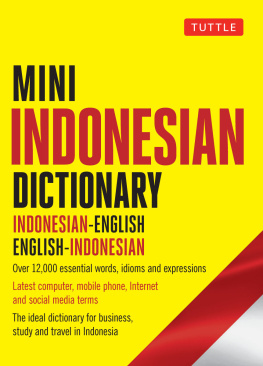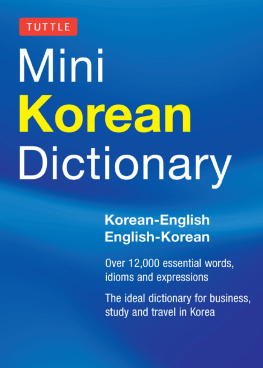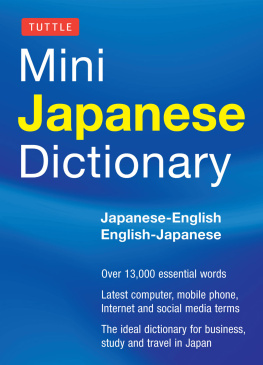Mini Indonesian Dictionary Indonesian-English
English-Indonesian Compiled by Katherine Davidsen  Published by Tuttle Publishing, an imprint of Periplus Editions (HK) Ltd. www.tuttlepublishing.com 2018 by Periplus Editions (HK) Ltd All rights reserved. ISBN 978-0-8048-5081-0 Distributed by:Indonesia PT Java Books Indonesia Jl. Rawa Gelam IV No. 9, Kawasan Industri Pulogadung Jakarta 13930 Tel: (62) 21 4682-1088 | Fax: (62) 21 461-0206 North America, Latin America and Europe Tuttle Publishing 364 Innovation Drive, North Clarendon, VT 05759-9436 USA Tel: 1(802) 773-8930 | Fax: 1(802) 773-6993 Asia Pacific Berkeley Books Pte. 61 Tai Seng Avenue #02-12, Singapore 534167 Tel: (65) 6280-1330 | Fax: (65) 6280-6290 22 21 20 19 18 5 4 3 2 1 1804RR Printed in China TUTTLE PUBLISHING is a registered trademark of Tuttle Publishing, a division of Periplus Editions (HK) Ltd. 61 Tai Seng Avenue #02-12, Singapore 534167 Tel: (65) 6280-1330 | Fax: (65) 6280-6290 22 21 20 19 18 5 4 3 2 1 1804RR Printed in China TUTTLE PUBLISHING is a registered trademark of Tuttle Publishing, a division of Periplus Editions (HK) Ltd.
Published by Tuttle Publishing, an imprint of Periplus Editions (HK) Ltd. www.tuttlepublishing.com 2018 by Periplus Editions (HK) Ltd All rights reserved. ISBN 978-0-8048-5081-0 Distributed by:Indonesia PT Java Books Indonesia Jl. Rawa Gelam IV No. 9, Kawasan Industri Pulogadung Jakarta 13930 Tel: (62) 21 4682-1088 | Fax: (62) 21 461-0206 North America, Latin America and Europe Tuttle Publishing 364 Innovation Drive, North Clarendon, VT 05759-9436 USA Tel: 1(802) 773-8930 | Fax: 1(802) 773-6993 Asia Pacific Berkeley Books Pte. 61 Tai Seng Avenue #02-12, Singapore 534167 Tel: (65) 6280-1330 | Fax: (65) 6280-6290 22 21 20 19 18 5 4 3 2 1 1804RR Printed in China TUTTLE PUBLISHING is a registered trademark of Tuttle Publishing, a division of Periplus Editions (HK) Ltd. 61 Tai Seng Avenue #02-12, Singapore 534167 Tel: (65) 6280-1330 | Fax: (65) 6280-6290 22 21 20 19 18 5 4 3 2 1 1804RR Printed in China TUTTLE PUBLISHING is a registered trademark of Tuttle Publishing, a division of Periplus Editions (HK) Ltd.
Introduction A brief introduction to Indonesian Indonesian is the national language of the worlds fourth-largest nation, spoken by at least 70% of the nations 250 million people. It is a mother tongue to over 27%, connecting speakers of 750 regional languages. As a variety of Malay, it is also understood in Singapore and Malaysia, making it a major language of Southeast Asia. An Austronesian language, modern Indonesian developed from Riau Malay into the official language of post-war independent Indonesia. It has borrowed widely from other languages and absorbed myriad influences, making it dynamic and always in flux. Indonesian is considered relatively easy to learn, having very regular grammar.
Adjectives follow the noun, as in French, and there is a wide range of verbs. Word order generally follows a subject-verb-object pattern. Words may be left out if the context is clear. Pronunciation is similar to Spanish or Italian, although accents vary.
| Vowels: | a | as in father |
| e | mostly as in loosen (swallowed shwa sound); sometimes as in egg. In older texts this is written as |
| i | as in marine |
| o | as in open |
| u | as in blue |
| Diphthongs: | ai | as in aisle |
| au | as in sauerkraut |
| Consonants: | as in English, except for: |
| c | like ch in child |
| g | always hard, as in gum, never soft as in gem |
| kh | throaty sound as in loch |
| ng | as in thing |
| ngg | as in finger (ng+g) |
| r | rolled, as in Spanish |
| sy | sh as in show |
The
Tuttle Mini Indonesian Dictionary aims to represent the modern, standard usage of Indonesian, through common entries, new terminology and authentic terms, as well as identify parts of speech.
A helpful, unusual feature is that this volume does not presume knowledge of word structure, which is vital when using most quality Indonesian dictionaries. For example, the word mengalahkan is listed under mengalahkan as well as its base, kalah in this dictionary. In most dictionaries, only the latter would appear. Selection of entries By definition, a mini dictionary is a selection of useful words and phrases, rather than a complete compendium. This dictionary attempts to reflect general, everyday usage throughout Indonesia and the English-speaking world, including words that are important to students, language learners and tourists. American spelling is used.
Entries cover survival language for tourists, common everyday words, national culture and language heard on the street. Guide to using this dictionary The dictionary is divided into two sections, IndonesianEnglish and EnglishIndonesian.
| menghadap | entry (in bold type) |
| halang: halangan | first word is not found (or commonly used) alone. Sub-entries follow after semi-colon, in bold black type |
| V | word type (ie part of speech). Not always given if more than one word type exists. cas charge (could be N, V) |
| child N children | irregular plurals follow the noun symbol N |
| put V put put | irregular past tense forms (simple past and past perfect) follow the verb symbol V |
| [nait] | irregularly-spelt words are given in Indonesian phonetic pronunciation |
| malam | meaning (in plain type) |
| session, meeting; hearing | Similar meanings are divided by commas; other meanings are divided by a semi-colon |
| ~ tiri stepmother; bahasa ~ mother tongue | Entries or sub-entries are indicated by ~ (in italics). cas charge (could be N, V) |
| child N children | irregular plurals follow the noun symbol N |
| put V put put | irregular past tense forms (simple past and past perfect) follow the verb symbol V |
| [nait] | irregularly-spelt words are given in Indonesian phonetic pronunciation |
| malam | meaning (in plain type) |
| session, meeting; hearing | Similar meanings are divided by commas; other meanings are divided by a semi-colon |
| ~ tiri stepmother; bahasa ~ mother tongue | Entries or sub-entries are indicated by ~ (in italics). On the left, ~ represents ibu. |
| ouch! ow! (expressions of pain) to (be able to) speak or use a language | Round brackets contain additional information; or perhaps an extra meaning. |
| baik maupun both and | represents any word, in a set phrase |
| bersih, membersihkan, pembersihhandwritinghand | Where possible, all entries and sub-entries are grouped alphabetically. A left-pointing arrow indicates the base word. |
| abishabisbecamebecome | A right-pointing arrow shows an entry for further information or reference; or the base of an irregular past tense verb form. |
Acknowledgments I would like to thank everyone involved in this dictionary project.
In particular, thanks to Eric M. Oey, Associate Professor Stuart O. Robson of Monash University, Nancy Goh, Tony Mansanulu, Judo Suwidji, and of course Johansjah Sugianto. I must also thank countless patient and helpful friends, the Sumirat family, the family of Moch. Yunus, the household of Fauzi Bowo, my own family in Melbourne, the Zeed family, and my students over the years. of an ethnic group; ~ istiadat customs and traditions; ~ Sunda Sundanese traditions adegan N scene adik N younger brother or sister; ~ ipar (younger) brother- or sister-in-law; ~ laki-laki (younger) brother; kakak-ber~ siblings; ~ kandung (younger) blood brother or sister;
Next page














 Published by Tuttle Publishing, an imprint of Periplus Editions (HK) Ltd. www.tuttlepublishing.com 2018 by Periplus Editions (HK) Ltd All rights reserved. ISBN 978-0-8048-5081-0 Distributed by:Indonesia PT Java Books Indonesia Jl. Rawa Gelam IV No. 9, Kawasan Industri Pulogadung Jakarta 13930 Tel: (62) 21 4682-1088 | Fax: (62) 21 461-0206 North America, Latin America and Europe Tuttle Publishing 364 Innovation Drive, North Clarendon, VT 05759-9436 USA Tel: 1(802) 773-8930 | Fax: 1(802) 773-6993 Asia Pacific Berkeley Books Pte. 61 Tai Seng Avenue #02-12, Singapore 534167 Tel: (65) 6280-1330 | Fax: (65) 6280-6290 22 21 20 19 18 5 4 3 2 1 1804RR Printed in China TUTTLE PUBLISHING is a registered trademark of Tuttle Publishing, a division of Periplus Editions (HK) Ltd. 61 Tai Seng Avenue #02-12, Singapore 534167 Tel: (65) 6280-1330 | Fax: (65) 6280-6290 22 21 20 19 18 5 4 3 2 1 1804RR Printed in China TUTTLE PUBLISHING is a registered trademark of Tuttle Publishing, a division of Periplus Editions (HK) Ltd.
Published by Tuttle Publishing, an imprint of Periplus Editions (HK) Ltd. www.tuttlepublishing.com 2018 by Periplus Editions (HK) Ltd All rights reserved. ISBN 978-0-8048-5081-0 Distributed by:Indonesia PT Java Books Indonesia Jl. Rawa Gelam IV No. 9, Kawasan Industri Pulogadung Jakarta 13930 Tel: (62) 21 4682-1088 | Fax: (62) 21 461-0206 North America, Latin America and Europe Tuttle Publishing 364 Innovation Drive, North Clarendon, VT 05759-9436 USA Tel: 1(802) 773-8930 | Fax: 1(802) 773-6993 Asia Pacific Berkeley Books Pte. 61 Tai Seng Avenue #02-12, Singapore 534167 Tel: (65) 6280-1330 | Fax: (65) 6280-6290 22 21 20 19 18 5 4 3 2 1 1804RR Printed in China TUTTLE PUBLISHING is a registered trademark of Tuttle Publishing, a division of Periplus Editions (HK) Ltd. 61 Tai Seng Avenue #02-12, Singapore 534167 Tel: (65) 6280-1330 | Fax: (65) 6280-6290 22 21 20 19 18 5 4 3 2 1 1804RR Printed in China TUTTLE PUBLISHING is a registered trademark of Tuttle Publishing, a division of Periplus Editions (HK) Ltd.